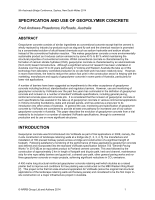Bridges

Specification and Use of Geopolymer Concrete
- Publication no: ABC-SAS203-14
- Published: 22 October 2014
- PDF (free) Download
Geopolymer concrete consists of similar ingredients to conventional concrete except that the cement is wholly replaced by industry by-products such as slag and fly ash and the chemical reaction is promoted by a concentrated solution of alkali-based chemicals such as sodium hydroxide and sodium silicate instead of the conventional hydration reaction. This makes geopolymer concrete a more environmentally sustainable product as it reduces carbon emissions by some 40 % to 80 % whilst maintaining the structural properties of conventional concrete. Whilst conventional concrete is characterised by the formation of calcium silicate hydrates (CSH), geopolymer concrete is characterised by an aluminosilicate (Si-O-Al-O) based microstructure. The need to reduce the carbon footprint in the construction sector is helping with the marketing, manufacture and supply of geopolymer concrete in some parts of Australia, particularly for lower-risk applications.A number of barriers have been suggested as impediments to the wider acceptance of geopolymer concrete including technical, standardisation and regulatory barriers. However, use and monitoring of geopolymer concrete by VicRoads over the past five years has culminated in the definition of geopolymer concrete and inclusion in a number of standard VicRoads specifications, including general paving, reinforced concrete pipes and concrete pits. It is considered that the inclusion of geopolymer concrete in such specifications has assisted in the take up of geopolymer concrete in various commercial applications in Victoria including foundations, slabs and precast panels, and has acted as a precursor to its introduction into other areas of Australia. The use, monitoring and specification of geopolymer concrete by VicRoads are considered to provide at least one pathway for its increased use in Australia. This paper describes the evolution of geopolymer concrete from trial material to its inclusion in a number of VicRoads specifications, through to commercial production and its use on more significant structures.
Related publications
ATM-780-23
ATS-5315-23
ATS-5341-23
Latest Bridges News
